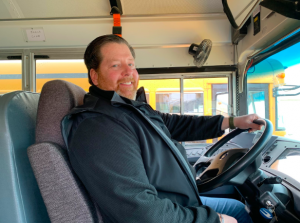The Life of a Bus Driver
A look into the daily life of a member of the Atlantic Community School District’s transportation department.
Atlantic Community School District bus driver Steve Andersen stands by one of the many buses at the bus barn on the edge of town. Andersen is one of the eight regular route bus drivers.
February 11, 2020
It’s just before 6 a.m. when Steve Andersen walks into the Atlantic Community School District bus barn and is welcomed by a familiar garage smell and freshly-brewed coffee. While some people are still sleeping, he and his fellow bus drivers are already fueled up and ready to start their day, picking up the kids on their routes to get them to school.
Andersen’s interest in bus driving peaked when he heard they needed substitute drivers. After, he applied for a substitute job and “really liked it.” At the time, his son Avery was still in school, so he’d ride to his games and other activities. “I’d be going to these events anyhow,” Andersen said. It was then that he decided to become a bus driver.
Andersen has lived his whole life Atlantic, minus the time he spent during college. As a child, he rode the bus but never thought he’d become a bus driver. Now, he drives the bus instead of riding it. Still, the destination remains the same.
This is Andersen’s second year driving a bus for the school, but his fifth year being a bus driver. He previously worked as transportation director for SWITA, where he initially got his commercial license.
Bus driving is technically considered a part-time job for Andersen. On a regular day, Andersen spends four or more hours at the bus garage. Instead of having an eight-hour work day, Andersen completes two routes, each that take about two hours. All bus drivers are required to clean and fuel their buses and attend regular training. In between the routes, Andersen and most other bus drivers attend their other jobs.
Also adding to his morning and afternoon routes, bus drivers are sometimes required to take bus trips out of town. This includes taking students to sporting, band, choir, and other extracurricular events taking place in surrounding towns. These trips can make for a ten to twelve-hour workday.

All bus drivers have their own assigned bus. Andersen named his “Marco” after one of the players from his favorite professional football team, the Pittsburgh Steelers.
There are eight other route bus drivers who come to the bus garage every day. According to Andersen, they “work well together” and “cover each other’s absences when needed.” This is helpful for Andersen, as he has other “jobs and responsibilities.” Andersen knew most of his fellow bus drivers before he started the job, as they all live in Atlantic.
When Andersen isn’t driving the bus, he’s working at his other jobs. He is the owner of his bottled water delivery business and bicycle shop. Andersen delivers water all over southwest Iowa. “Unlike the kids on the bus, the bottles tend to stay in place and be quiet,” he said.
What Andersen enjoys most about bus driving is spending time with the kids. Most of his riders live north of town. Some of them can spend up to an hour on the bus. Others may be on and off the bus in as little as ten minutes, depending on their spot on the route. “Even though I drive the same route every day, each day is different,” Andersen said. He especially likes driving during the holidays, weekends, or birthdays “to hear what they’re doing.” If one of the kids has a birthday, Andersen lets them sit wherever they want and choose what music channel is played on the bus that day.
While Andersen enjoys talking to the kids, he always remembers the importance of his job. “My number one job is to get them from one place to another safely. Everything after that is secondary,” he said. Safety precautions include making sure all children on the bus are seated and facing the right direction “in case a deer runs out or a traffic incident happens.”
During the winter months, all bus drivers must take extra precautions, especially considering they have to drive on gravel roads, as “sometimes the paved roads are in better condition.” Andersen said, “We’re not the ones who decide when school closes, so when it’s snowy and foggy, it’s something we have to be aware of.” This includes taking more time than usual and paying extra attention to the road and the things around it.
Everyone in the transportation department for ACSD holds an important job, whether they’re driving their normal routes, or taking kids to an extracurricular event out of town. They all have the common goal of getting their riders from one point to another, safely.










